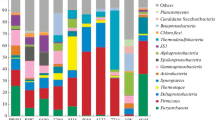Abstract
An analysis of Ust-Tegussky oil-field formation waters is conducted, the cultures of sulfate-reducing bacteria (SRB) are isolated from these waters, and their taxonomic status is determined. The formation waters used for the maintenance of intrasheeted pressure on the Ust-Tegussky field are characterized by moderate mineralization (23.2 g/L) and contain sulfate (8.4 mg/L). The sulfate-reducing enrichment culture was isolated from the studied waters and contained three bacterial strains by results of TGGE. Fragments of 16S rRNA genes of strains Y1 and Y2 are genetically close to Desulfovibrio alaskensis and D. psychrotolerans with a similarity of 99.0 and 95.0%, respectively. Strain Y2 is isolated in pure culture and partially characterized. A phylogenetic analysis of almost a full sequence of 16S rRNA gene of strain Y2 has shown that, out of all known species, it is closest to the strain type of D. psychrotolerans isolated from the saline lake and the similarity of 96.5% suggests a description of a new species. It is shown that the new SRB are inhabitants of the formation waters arriving with extracted oil.
Similar content being viewed by others
References
Abdulina, D.R., Asaulenko, L.G., and Purish, L.M., The composition of the microbial communities in different ecological and technological areas Sostav mikrobnykh soobshchestv v raznykh ekologo-tekhnogennykh zonakh, in Biologiya—nauka KhKhI veka: Sb. tez (Abstr. Conf. “Biology—The Science of the XXI Century”), Pushchino, 2011, pp. 342–343.
Asfandiyarov, F.A., Kil’dibekov, I.G., and Nizamov, K.R., Metody bor’by s sul’fatvosstanavlivayushchimi bakteriyami i vyzyvaemoi imi korroziei stali (Methods of Dealing with Sulfate-Reducing Bacteria and Resulting Corrosion of Steel), Moscow: VNIIOENG, 1983.
Microbial Life in Extreme Environments, London: Acad. Press, 1978.
Zavarzin, G.A., Lektsii po prirodovedcheskoi mikrobiologii (Lectures on the Natural History of Microbiology), Moscow: Nauka, 2004.
Koronovskii, N.V. and Yakushova, A.F., Osnovy geologii (Fundamentals of Geology), Moscow: Vyssh. Shk., 1991.
Kuznetsov, S.I., Ivanov, M.V., and Lyalikova, N.N., Vvedenie v geologicheskuyu mikrobiologiyu (Introduction to Geological Microbiology), Moscow: Izd. AN SSSR, 1962.
Manual of Methods for General Bacteriology, Washington: Amer. Soc. Microbiol., 1981.
Netrusov, A.I., Bonch-Osmolovskaya, E.A., Gorlenko, V.M., et al., Ekologiya mikroorganizmov (Ecology of Microorganisms), Moscow: Akademiya, 2004.
Nizamov, E.M., Gutman, K.R., and Getmanskii, M.D., Zashchita neftepromyslovogo oborudovaniya ot korrozii (Protection of Oilfield Equipment from Corrosion), Moscow: Nedra, 1983.
RD 39-3-973-83. Metodika kontrolya mikrobiologicheskoi zarazhennosti neftepromyslovykh vod i otsenka zashchitnogo i bakteritsidnogo deistviya reagentov (RD 39-3-973-83. Technique of the Control of Microbiological Contamination of Oilfield Waters and Evaluation of Protective and Bactericidal Action of Reagents), Ufa: VNIISPTneft’, 1984.
Reznikov, A.A., Mulikovskaya, E.P., and Sokolov, I.Yu., Metody analiza prirodnykh vod (Methods of Analysis of Natural Waters), Moscow: Nedra, 1970.
Rozanova, E.P. and Kuznetsov, S.I., Mikroflora neftyanykh mestorozhdenii (Microflora of Oil Fields), Moscow: Nauka, 1974.
Smolyanets, E.F., Ragulin, V.V., Daminov, A.A., et al., Analysis of microbiological contamination of surface equipment fields in Western Siberia, in Zashchita ot korrozii i okhrana okruzhayushchei sredy (Protection from Corrosion and Environmental Protection), 1997, pp. 17–23.
Sulin, V.A., Gidrogeologiya neftyanykh mestorozhdenii (Hydrogeology of Oil Fields), Moscow: Gos. Nauch.-Tekhn. Izd. Neftyan. Gorno-Topliv. Literatury, 1948.
Cline, J.D., Spectrophotometric determination of hydrogen sulfide in natural waters, Limnol., Oceanogr, 1969, vol. 14, pp. 454–458.
Cord-Ruwisch, R., Kleinitz, W., and Widdel, F., Sulfate-reducing bacteria and their activities in oil production, J. Petroleum Technol., 1987, January, pp. 122–131.
Feio, M.J., Zinkevich, V., Beech, I., et al., Desulfovibrio alaskensis sp. nov., a sulphate-reducing bacterium from a soured oil reservoir, Int. J. Syst. and Evol. Microbiol., 2004, vol. 54, no. 5, pp. 1747–1752.
Gieg, L.M., Jack, T.R., and Foght, J.M., Biological souring and mitigation in oil reservoirs, Appl. Microbiol. Biotechnol., 2011, vol. 92, no. 2, pp. 263–282.
Luo, L., Liu, Y.J., and Wang, X.C., Distribution and diversity of sulfate-reducing bacteria in a crude oil gathering and transferring system, Huan Jing Ke Xue, 2010, vol. 31, no. 9, pp. 2160–2165.
Muyzer, G. and Stams, A., The ecology and biotechnology of sulphate-reducing bacteria, Nature Reviews. Microbiol., 2008, vol. 6(June), pp. 441–454.
Rao, J., Ranade, D., Shouche, Y., et al., Sulfate-reducing bacteria isolated from an oilfield in India are most closely related to strains of Desulfovibrio from geographically remote oil fields, in Abstract 3rd Int. Symp. on Applied Microbiology and Molecular Biology in Oil Systems, Calgary, 2011, p. 40.
Saitou, N. and Nei, M., The neighbor-joining method: a new method for reconstructing phylogenetic trees, Mol. Biol. Evol., 1987, no. 4, pp. 406–425.
Jyothsna, T.S., Sasikala, Ch., and Ramana, Ch.V., Desulfovibrio psychrotolerans sp. nov., a psychrotolerant and moderately alkaliphilic sulfate-reducing Deltaproteobacterium from a Himalayas, Int. J. Syst. Evol. Microbiol., 2008, vol. 58, pp. 821–825.
Selection, Application, and Evaluation of Biocides in the Oil and Gas Industry, NACE International Publication 31205, Item No. 24227, Houston, 2006.
Street, C.N. and Gibbs, A.J., Eradication of the corrosion-causing bacterial strains Desulfovibrio vulgaris and Desulfovibrio desulfuricans using photodisinfection, in Northern Area Western Conference, Calgary, 2010, p. 14. http://www.nacecalgary.ca
Takii, S., Hanada, S., Hase, Y., et al., Desulfovibrio marinisediminis sp. nov., a novel sulfate-reducing bacterium isolated from coastal marine sediment via enrichment with casamino acids, Int. J. Syst. Evol. Microbiol., 2008, vol. 58, pp. 2433–2438.
Tamura, K., Peterson, D., Peterson, N., et al., MEGA5: molecular evolutionary genetics analysis using maximum likelihood, evolutionary distance, and maximum parsimony methods, Molecular Biol. Evol., 2011, vol. 28, no. 10, pp. 2731–2739.
Thompson, J.D., Higgins, D.G., and Gibson, T.J., CLUSTAL W: improving the sensitivity of progressive multiple sequence alignment through sequence weighting, positions-specific gap penalties and weight matrix choice, Nucleic Acids Res., 1994, vol. 22, pp. 4673–4680.
Author information
Authors and Affiliations
Corresponding author
Additional information
Original Russian Text © T.V. Drogaleva, Ya.V. Ryzhmanova, M.B. Vainstein, 2015, published in Biologiya Vnutrennikh Vod, 2015, No. 1, pp. 13–18.
Rights and permissions
About this article
Cite this article
Drogaleva, T.V., Ryzhmanova, Y.V. & Vainstein, M.B. Sulfate-reducing bacteria in formation waters of the pressure maintenance system of Ust-Tegussky oil deposit. Inland Water Biol 8, 9–14 (2015). https://doi.org/10.1134/S1995082915010058
Received:
Published:
Issue Date:
DOI: https://doi.org/10.1134/S1995082915010058



